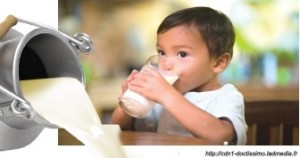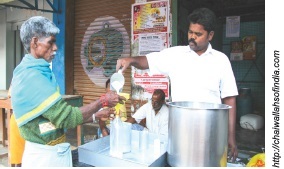Oct.17: COVER STORY
- Posted by CERC India
- Posted in October 2017, Uncategorized
70% of loose milk samples unfit for human consumption
Samples from door-to-door vendors and local dairies found to be of very poor quality
India is the largest producer of milk in the world. But, only 25–30% of the milk produced in the country is processed and packed for sale by the organized dairy sector. The remaining milk is either locally consumed or handled by the unorganized sector in an unhygienic manner. As a result, the consumer receives milk of questionable quality. Shockingly, a survey conducted by the Food Safety and Standards Authority of India (FSSAI) in 2012 found 68% of the milk in the country to be contaminated.
Milk quality is undermined by the following three factors:
(i) Adulteration: Milk is commonly diluted with water. This not only reduces its nutritional value, but contaminated water can cause health problems. Other adulterants include starch, detergents, caustic soda, fertilizers like urea and ammonium sulphate, and white paint.
(ii) Contamination: Residues of antibiotics and hormones given to cattle get into the milk. Pesticides and heavy metals also find their way into milk. Cattle in urban areas roam the streets foraging for food and end up eating large quantities of plastic. All these factors can make the milk they produce toxic.
(iii) Microbial content: Milk is a perfect medium for the growth of microorganisms due to its high nutritive value and high moisture content. Microbial content is determined by health of the animal, its living conditions, cleanliness of handlers and storage vessels. If the animals are not cleaned properly, their waste can make its way into the milk during milking. Once microorganisms enter milk, they multiply due to warm ambient temperature resulting in fast deterioration of the product.
What we did
We addressed the concern related to microbial content in this test report. Fifty-five loose milk samples were collected from different areas of Ahmedabad – 50 from local dairies and five from door-to-door vendors. The areas were selected so as to cover all parts of the city. Though several brands of packed pasteurized milk are available, some consumers prefer to buy loose milk from vendors due to the perception that loose milk is fresh, healthier and chemical free.
All the samples were tested for three microbiological parameters – MBRT (Methylene Blue Reduction Test), Plate Count and Coliforms – as per the Indian Standards.
Key findings
- Alarmingly, 33 out of the 50 samples showed the presence of Coliforms over the limit making them unfit for consumption unless the milk is thoroughly boiled or pasteurized.
- Regarding MBRT and Plate Count, 16 of the 50 loose samples from dairies were graded as fair and 10 as poor.
- The five samples collected from vendors supplying milk at homes failed in all three parameters and were found to be of very poor quality.
Significance of parameters
MBRT: This test is carried out to find out the bacterial content of milk by measuring how long it takes for the bacteria in the milk to decolorize methylene blue. The less the time taken the poorer the quality of milk. Accordingly, the milk is graded as very good (5 hours and above), good (between 3 and 4 hours), fair (between 1 and 2 hours) and poor (half an hour). Bacteria can adversely impact health by causing gastroenteritis, food poisoning and intestinal irritation. MBRT is a qualitative test.
Plate Count: This indicates the total number of viable bacteria in milk. As per the Plate Count per ml, raw milk is graded as very good (not exceeding 2 lakh), good (between 2 and 10 lakh), fair (between 10 and 50 lakh) and poor (over 50 lakh). Plate count is a quantitative test.
Coliforms: The presence of these microorganisms indicates possible fecal contamination. Coliform bacteria can cause bloody diarrhea, vomiting, urinary tract infections and typhoid. Coliforms are generally destroyed during pasteurization. If Coliforms are absent in 1:100 dilution, the milk is of satisfactory quality.
 Urgent action needed
- To procure milk we need healthy milch animals. The animals should be kept in clean surroundings and fed nourishing food.
- Hygiene needs to be practiced while milking, collection, storage and distribution.
- Strict action should be taken against adulterators.
- Milk and dairy products are sourced from several million farmers in India. However, regulations do not cover these farmers.
- Consumers should be made aware of the hazards of buying loose milk.
What consumers can do
- Avoid raw milk sold loose in local dairies and by door-to-door milk vendors.
- If you do buy raw milk, drink it only after boiling. Boil pasteurized milk too.
- While boiling, keep on stirring. Cool the milk quickly to minimise the loss of vitamins, minerals and protein.
- Store milk in the refrigerator after boiling to minimise bacterial contamination.
- Keep fresh milk cold, sealed (so it won’t absorb other flavours and odours), and in the dark.
- Don’t sell milk packets as they are recycled by unscrupulous adulterators. Destroy them before discarding them.
Testing for adulteration
To detect adulteration in milk you can carry out simple tests at home. For instance, to test for urea, place a teaspoon of milk in a glass container. Add a teaspoonful of soya bean or tuar dal powder. Mix thoroughly. After five minutes dip a strip of red litmus paper in the mixture. Wait for half a minute. If it turns blue there is urea in the milk. To test for detergent, take 5 ml of milk and an equal quantity of water in a container. Shake it well. Lather formation indicates presence of detergent in the milk.Â
Grahak Sathi’s conclusion
Gone are the days when cows grazed in lush green fields and you could be assured of getting milk from healthy, well-fed animals. You can’t trust local doodhwallas to adhere to the safety standards. So, buy only packed pasteurized milk that is safe for human consumption.






